Boka kotorska
The region of Boka kotorska is situated on the south-east of Dubrovnik and Konavle, along the Adriatic coast from Herceg Novi to very near the town of Bar. It was named after the town of Kotor, which is placed in a fascinating fjord.
Croatian benedictins in Boka kotorska had their abbeys since at least the year 1066. There were at least seven of such abbeys:
- Sv. Juraj near Perast,
- Sv. marija de Resson,
- Sv. Luka in rtoli, Sv. Mihovil in Prevlaka,
- Sv. Nikola from Petranac,
- Sv. Petar from Gradac, and
- Sv. Marko de Pinita.
The benedictins in Boka kotorska appeaar in the 9the or the beginning of the 10th century. A Bull of pope Clement III from 1089, and to a Bull of pope Calisto II from 1124, confirm that on the territory of Duklja (Doclea) there were abbeys that were designated as latinorum, graecorum et sclavorum (Glagolitic benedictine abbeys), under the auspices of Duklja-Bar archbishops. The source of this information is [Ivan Ostojić].
Boka kotorska was annexed to Montenegro in 1945. At that time it was populated mostly by Croatian Catholics (Bokelji). Now the ethnic situation in this region is entirely different, especially after 1991.
Archbishop Vicko Zmajevic (1670.-1745.), born in Perast, brought the Bar Catholics (from the environs of the city of Bar, descendants of Red Croatians), endangered by the Turks, to the environs of Zadar where they live also today. He built a school “Collegium Illiricum” or “Seminarium Zmajoillyricum” in Zadar for educating Glagolitic priests (today archbishops school “Zmajevic”). His brother Matija Zmajevic was a famous admiral of the Russian tsar Peter the Great, see below.
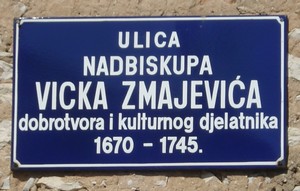
A street in Zadar (Arbanasi) named after Vicko Zmajevic, founder of Zmajevicevo glagoljasko sjemeniste in Zadar
Glagoljica u Arbanasima kod Zadra
Photos: Moris Nakic, Soni Banic, Dario Tikulin i don Zdenko Milic (Zadar)
In Perast the first nautical school has been founded by the end of 17th century. It is considered to have been founded by Marko Martinovic (1663-1716), a famous Boka mariner. In 1698 the Russian Emperor Peter the Great sent 16 young Russian nobleman to Boka to attend maritime studies in Perast, in order to be able to organize the future Russian Navy. See Croatian Encyclopaedia (Boka kotorska in Volume III).
The Bokelj’s had a very strong fleet, which counted as many as 300 ships in the 18th century. Boka was a rival to Dubrovnik and Venice. It is worth mentioning that one of the Bokeljs – Matija Zmajevic (1680-1735) – was the admiral of Baltic navy and the ship-builder of the famous Russian tsar Peter I the Great, and for whom he built a fleet in Voronez.

Matija Zmajevic had great successes in maritime battles against Sweden, and for this reason he was decorated with the Order of Aleksandar Nevski by Empress Katarina. Peter I the Great took of his personal sward and donated it to Matija Zmajevic in recognition of his military successes. Matija Zmajevic had the honour to carry the crown of Romanov’s during the funeral of Peter the Great in 1725. Zmajevic was buried with greatest military honours in the Catholic church in Moscow. Peter the Great sent some of his young officers (bolyars) to the town of Perast in Boka in order to study maritime sciences there. For more information see [Milos Milosevic, pp 244-251].
Marko Vojnovic from Hercegnovi organized the Russian marine on the Black Sea, and achieved the status of admiral. Matija Melada of Perast, a well known engineer of his time, arranged many Russian ports. See Croatian Encyclopaedia (Boka kotorska in Volume III).
Boka kotorska region is under protection of UNESCO, due to its very rich Croatian cultural heritage. The region around the town of Kotor is situated in probably the most beautiful fjord in Europe. In 1979 there was an earthquake that destroyed or seriously damaged numerous cultural monuments.
Very important historical source for early Croatian history is Libellus Gothorum, a chronicle from 12th century known in Croatia as Ljetopis popa Dukljanina. It was written by Archbishop Grgur of Bar, born in Zadar, and Bar is a coastal town near Boka kotorska. The chronicle represents the oldest historiographic work of Croatian Middle Ages.
It is interesting that Tripun Kotoran, a Kotor goldsmith, worked on the court of Ivan Grozny in Moscow in 1476. One of the earliest Croatian typographers was Andrija Paltasic (~1450-1500), born in the town of Kotor. He was one of the best Venetian typographers around 1480, who printed more than 40 incunabula, among them the Bible in Italian language. We also mention by the way that a very old missal from 12th century – the Kotor missal, is held in St. Petersburg, Russia.
Nikola Modruski (Lat. name Nicolaus Machinensis, Italian name Nicolo di Cattaro, ~1427-1480), born in Boka kotorska, was bishop of Modrus in Lika, Pope’s representative at the court of Stjepan Tomasevic in Bosnia, and on the court of the Hungarian king Matijas Corvin in Budim, his huge library was left to the newly founded Vatican library (founded by Pope Sixto IV). In 1478/79 he wrote a treatise in defense of the Glagolitic Script which he sent from Rome to the Modrus Diocese. It is regarded to be the first polemic treatise in the history of Croatian literature, and it was written in the Glagolitic Script. Buried in the church of Sta Maria del popolo in Rome.
In the village of Bogdasic near Tivat, in the church of Sv. Petar, a Croatian Glagolitic inscription has been found. Also the Glagolitic mass (i.e. Catholic mass served in Croatian Church Slavonic language instead of Latin language) has been in use in the church. The same for the village of Kostajnica near the town of Perast. These two parishes were glagolitic also in the 19th century. See [Pederin, p 247]. Many thanks to dr. Vanda Babic for information about the Bogdasic Glagolitic inscription.
Ljubica Štambuk: Tragovi glagoljice u Boki (Traces of the Glagolitic Script in Boka)
Sea-captain Krsto Corko, born in Perast, was Spanish Marquis and Governor of Ballearic Islands in the second half of the 17th century.
Kristofor Ivanovic, a Canon of the town of Budva in Boka kotorska, published his Memorie teatrali in Venice in 1681. It was the first history of Venetian opera, covering the period of 1637 – 1681. Its 2nd edition appeared in 1687.
The first balloonist in Croatia was Karlo Mrazovic, who performed two balloon flights in Zagreb with his own balloons in 1789 and 1790. He was born in Boka kotorska. See [Croatia – Europe, III, Barok i prosvjetiteljstvo, p. 426, the article by Vladimir Muljevic].
Captain Petar Zelalic (Zhelalich), 18th century, born in Boka kotorska, was a member of Order of Maltese Knights. He became famous after his ship defeated a huge Turkish ship called “The Ottoman Crown.”
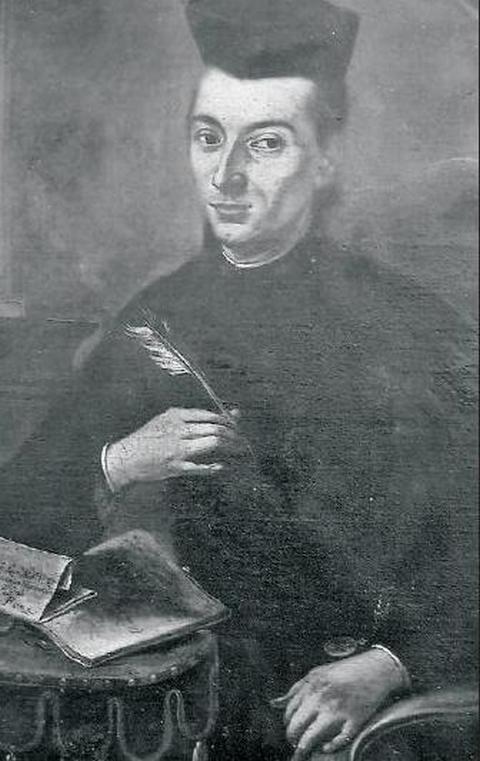
Josip Marinović
Josip Marinovic (1741 – 1801), was a Jesuit born in Perast – Kotor (in Boka kotorska, annexed to Montenegro in 1945), professor of theology in Venice. His friendship with an Armenian banker Serpos resulted in his interest for the history of Armenians. His assiduous research resulted in the book “Compendio storico…della nazione armena”, published in Venice in 1783. The book had a great success. Though it was signed by Serpos, its true author was Marinovic. It represents the first history of Armenians published in Europe. It is interesting that the book had been extended and republished by Ivan Dominik Stratico (1732-1799), bishop on the Croatian island of Hvar. This book incited European interest for Armenian people and their culture. In particular, upon the initiative of the Vatican, supported by Austria and Russia, in 1830 the Turkish sultan admitted very old Armenian Christian Church and allowed Armenian Archdiocese to be founded in Constantinople. See [Gregory Peroche], p. 119, and [V. B. Lupis, O armensko-hrvatskim kontaktima].
Armenian and Croatian contacts described by Vinicije B. Lupis
In 1782 Krsto Mazarevic from the city of Kotor (in today’s Montenegro) performed a flight in two balloons.
Another outstanding Croat is captain Ivan Visin born in Prcanj in Boka. His travel around the world started in Antwerpen in 1852 (his ship “Splendido”, built in Rijeka, was 30m long, 311 metric tons of cargo) and ended successfully in Trieste in 1859, having sailed 101,000 nautical miles (the circumference of the Earth is 21,600 n.m.; the ship sailed in westward direction around the Earth, which is more difficult than in the opposite direction). Visin was only the sixth after Magellan to do a similar exploit.

For his brave undertaking, which was of the historical importance, he had been decorated by a flag of honour Merito navali by the Austrian Emperor (in fact, Visin was the only one who ever obtained such an honour). The trophy is held in Prcanj. Visin also became the honorary citizen of Trieste.

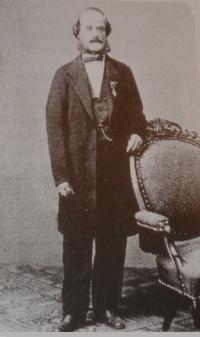
Ivo Visin in Trieste in 1860, photo from [I Croati di Trieste]
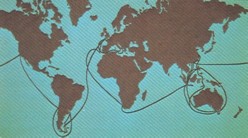
Anton Lukovic (1815-1880), descendant of an old Croatian family from Boka kotorska, was a chief engineer in the project of building the Suez Canal (1859-1869).

Anton Luković (1815-1880), one of the principal engineers
in the project of building the Suez Canal
Born in Prčanj, Luković was among the principal engineers who participated in building the Suez Canal (193.3 km), completed in 1869. He worked there as an Austrian architect and civil engineer.

Luković’s Dario Palace in Canal Grande in Venice
He was proprietor of a monumental palace Dario in Canal Grande in Venice, where he died in 1880. The palace appears on the work of art by Claude Monet, distinguished French painter, which is kept in the Museum of Art in Chicago. He also had a merchant house in Cardiff. An important fortress at the entrance of the port in Alexandria was built according to his project. During this work, he discovered three old-Egyptian columns from 16-14 century BC carved with hyerogliphics, which were subsequently solemnly donated to Austrian Emperor Franz Joseph I on the occasion of the offical opening of the Suez Canal. The columns are now kept in Vienna, in Egyptian Antiquties Room of the Museum of Art History (Kunsthistorisches Museum). 
Egyptian pillars discovered by Anton Lukovic, placed in Kunshistorisches Museum in Vienna.
Photo by Tianlan Xie.
For his merits, Lukovic earned heridetary nobility from the Austrian Emeror, and the title of Lukovic de Ascrivio. For more details see an article by Siniša Luković appearing in [Vidmarović, Hrvati Boke kotorske kroz povijest, pp. 375-379].
The Bokelj Marine 809 (Bokeljska mornarica 809) is a confraternity whose aim is to preserve more than a thousand year’s Croatian maritime tradition. In 809 the remains of St Tripun were brought by Croatian mariners from Asia Minor to Kotor. The Cathedral of St Tripun in Kotor is the oldest Croatian cathedral in this area built by Croats in 1166.

Croatian Coat of Arms was a part of a solemn uniform of the Boka Marine (Bokeljska mornarica).
The suit, kept in Croatian History Museum in Zagreb, is dating from the second half of the 19th century.
It is worth mentioning that New Yugoslavia participated at the international maritime exhibition EXPO’98 in Lisabon, Portugal, with Croatian cultural and maritime heritage of Boka kotorska. This very old and rich heritage was presented as Yugoslav without even mentioning that it belongs to the Croats in Boka kotorska. One can say that the Croats had in fact two pavilions in Lisabon: one belonging to Republic of Croatia (generally considered as one of the most original pavilions on the exhibition), and the other hidden under the name of Yugoslavia.
Yugoslav press (and even some Croatian!) used to add an innocent number 1 to 809, to obtain 1809, thus reducing the rich history of Croatian mariners in Boka kotorska for no less than 1000 years!
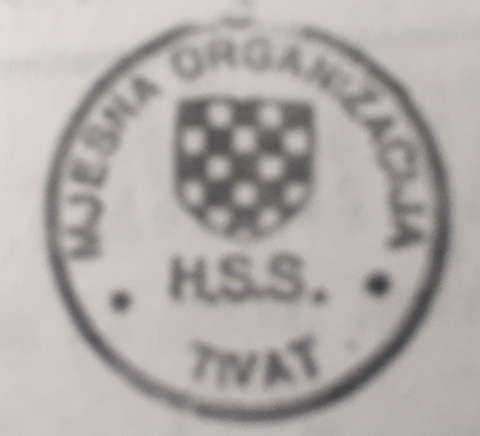
Seal of H.S.S. (Hrvatska seljačka stranka – Croatian Peasant Party)
in the town of Tivat in Boka kotorska, 1928. The founder and leader of H.S.S. was Stjepan Radic.
Note its Croatian Coat of Arms. Photo from [Vidmarovic, Prilog povijesti Hrvata Gornje i Donje Lastve].
A delegation of the Bokelj mariners from Boka kotorska participated with their traditional uniforms at the funeral of Stjepan Radic in Zagreb, after his assassination in the Yugoslav Parliament in Belgrade in 1928.

B. Ivankovic (1815-1898): A Kotor sailing ship, 19th century, source Matrix Croatica
Boka kotorska is also known as the Bay of Croatian saints. Out of eleven Croatian saints and blessed (St Leopold Mandic, St Nikola Tavelic, St Marko of Krizevci, Bl Augustin Kazotic, Bl Ozana of Kotor, Bl Jakov Zadranin, Bl Gracija of Mulo, Bl Julijan of Bale, Bl Alojzije Stepinac, Bl Ivan Merz, Bl Marija Petkovic), three of them are from Boka kotorska:
- St Leopold Bogdan Mandic (1866-1942),
- blessed Ozana Kotorka (Kata Kosic, 1493-1565),
- blessed Gracija from Mulo (1438-1508).

St Leopold Bogdan Mandic (1866-1942, memorial day 30th July) was born in Herceg Novi in Boka kotorska, and died in Padova, Italy. Physically malformed and delicate, having height only 1m 35cm, with clumsy walk and stuttering, he developed tremendous spiritual strength. Although he wanted to be missionary in Eastern Europe, he spent almost all of his adult life in Italy, and lived in Padova from 1906 until the end of his life. He spent also one year in Italian prison during the WWI, since he did not want to renounce his Croatian nationality, see here. He dreamed unceasingly about going to Orient, but one day he gave Communion to a very good person. And, as he described:
After finishing her thanksgiving, she came to me with this message: “Father, Jesus ordered me to say this to you: Your Orient is each of the souls you assist by hearing confessions.” (see here).
He became known as Apostle of Confession and Apostle of Unity. Here is a famous prayer in honour of this forerunner of today’s Ecumenism:
O God, source of life and love, you gave Saint Leopold a tremendous compassion for sinners and a desire for church unity. Through his prayers, grant that we may acknowledge our need of forgiveness, show love to others, and strive to bring about a living unity among Christians. Through Our Lord Jesus Christ, who lives and reigns for ever and ever. Amen.

St Leopold Bogdan Mandić (1866-1942), Croatian saint,
Also the famous Pope Sixto V has Croatian roots from Boka kotorska on his father’s side.
Out of 38 churches existing in the Kotor region (annexed to Montenegro in 1945) 36 are Catholic and only 2 are Orthodox (one of them was a gift of the Croats in Boka kotorska). On the photo you can see two beautiful churches on islets in the Boka bay, belonging to the Croatian Catholic community in Montenegro, built in the first half of the 17th century (Sveti Juraj and Gospa od Skrpjela near the town of Perast). It is interesting that the Church of Gospa od Skrpjela (on the photo) is built on an artificial island! Each year a procession of Croatian Catholics encircles in numerous fishing boats the island of Gospa od Skrpjela and pilgrims throw pebbles around it.
An important monument, showing uninterrupted presence of the Croats in Boka kotorska during many centuries, is the cathedral of St Tripun in the town of Kotor, built as early as 1166. As we have said, it represents the oldest known Croatian cathedral. Its ciborium is decorated with a beautiful interlace pattern which is even older than the church itself, and of the same type as numerous exotic interlace patterns found in many pre-Romanesque churches along the Croatian littoral. The town of Kotor has a surrounding wall which is about 5km long.
The benedictine order is present in the region of Boka kotorska since the 9th century. Today this region has about a hundred of Catholic churches and chapels.
The town of Perast had extremely difficult moments in 1654 when the attacks of the Turks were especially dangerous. Their brave and successful defense of Boka was the reason of the arrival of Petar Zrinski, a famous Croatian statesman, who also had numerous dramatic battles with the Turks. During his three day sojourn in Perast he presented his legendary sword to the town, as the sign of his recognition to their efforts to defend their homeland, and to stop the approach of the Ottoman Empire to Middle Europe.


Many thanks to Smiljana Sunde and Vesna Svagusa for photos.
| NA VJECNU USPOMENU KAD PETAR KNEZ ZRINJSKI, VOJVODA HRVATSKI, POTOM BAN IZA SLAVNE POBJEDE JUNAKA PERASTANA NAD TURCIMA ODVJETOVANJEM GOSPE OD SKRPJELA 15.V.1654. DOJEDRI SVOJIM BRODOM 23-24.V.1654. U PERAST DA CESTITA KAKO RECE : SLAVNOM SRETNOM I PLEMENITOM PERASTU DAROVAVSI IM JUNACKU SABLJU P. GRAD PERAST – 15.V.1928. |
| FOR ETERNAL REMBERANCE WHEN PETAR PRINCE ZRINJSKI, CROATIAN DUKE AND BAN AFTER A FAMOUS VICTORY OF PERAST HEROS OVER THE TURKS WITH HELP OF GOSPA OD SKRPJELA 15.V.1654. SAILED WITH HIS BOAT 23-24 V 1654 TO PERAST TO CONGRATULATE AS HE SAID : TO THE FAMOUS, HAPPY AND NOBLE PERAST PRESENTING IT WITH HIS BOLD SABRE P. GRAD PERAST – 15.V.1928. |
An article dealing with the Zrinski sword in Perast has been written by Dr Pavao Butorac (1888-1966), bishop of Kotor since 1938 and of Dubrovnik since 1950.
In 1944, bishop Pavao Butorac had to escape from Kotor to Dubrovnik in front of partisans, saving his life. Since then, the Kotor Diocese was without any bishop until 1970s. Information by academician Josip Pecaric.
Many Croatian artists (like Tripo Kokolja) have described the struggle of Bokeljs against the Turks. The verses of “Kotor Knights” written by Andrija Kacic Miosic(1704-1760) in his famous book “Razgovori ugodni naroda slovniskog” (published in Venice, 1756, 1759) start as follows:
| Ej Kotore, gnizdo sokolova, na visokoj grani savijeno, di se legu zmaji i sokoli, koji caru puno dodijase! Svijeno je na jeli zelenoj ter pokriva Buku od Kotora, kojano je dika od Hrvata i vitesko srce od junaka.” |
As we see, the verses describe Kotor as the nest of falcons, and as the pride of Croats. Kacic’s book was enormously popular in Croatia. It was translated by A. Fortis, and some of the verses appear in Herder’s “Volkslieder”. Some of the verses were translated also into French, and even into Latin. In Croatia the book had about eighty editions!
One of Croatian churches, given as a gift to Serbian Pravoslav Church in Kotor already in 1657 (during Venetian rule), was the church of St Luka in Kotor. The church itself is much older, and dates from 1195. Above the main entrance to the Church we can now read the following inscription “Serbian Pravoslav Church – 1195.” This falsification that appeared in 1990’s aims to “prove” that the Serbs built this church already in 1195. In 1995 the Serbs in Montenegro even “celebrated” 800th anniversary of this church which was Catholic until 1657, when it was given as a gift to Serbian Pravoslavs.

One of the greatest Croatian Baroque painters is Tripo Kokolja (1661-1713), born in the town of Perast in Boka kotorska, whose works of art are held in the Church of Gospa od Skrpjela, and also in the Dominican church in Bol on the island of Brac, in the townn of Hvar on the island of Hvar, in the town of Korcula on the island of Korcula (where he died), and in the city of Dubrovnik.
When a Russian travel-writer P.A. Tolstoy visited Boka in 1698, he noted that the local hills are also inhabited by the Croats.
Jozo Kljaković (1889-1969) is distinguished Croatian painter and illustrator. His paintings and murals are mainly of religious content. Kljaković is best known for his frescos that he painted in the church of St. Mark in Zagreb, in the parish churches of Vranjic (near the city of Split), in Dobrota in Boka kotorska, and in the memorial church in Biskupija near the town of Knin, as well as for his mosaics in the Pontifical Croatian St. Jerome Institute in Rome. He left Croatia in 1943, and spent the following 25 years in Rome and Buenos Aires.
A distinguished Croatian composer Ivan Brkanovic (1906-1987) was born near the town of Kotor in Boka kotorska. He studied at the Music Academy in Zagreb. Among others he was a director of The Zagreb Philharmony and professor at the University of Sarajevo. He composed Bokeljsko kolo, Konavosko pirovanje, opera Zlato Zadra (Gold of Zadar), etc.
Croatian Working Society Progress (Hrvatsko Radnicko Dru±tvo Napredak), Kotor 1901
From the front cover page of Stolacko kulturno proljece, Godisnjak za povijest i kulturu, god. VII., 2009.
Note Croatian Coat of Arms on the tricolor flag
Croatian tamburitza players in Kotor in 1901
In the Boka kotorska churches there are important works of art of many outstanding Croatian artists, like Ivan Mestrovic, Antun Augustincic, Celestin Medovic, and other.
Important Croatian poet born in the town of Kotor is Viktor Vida (1913-1960), since 1945 living in Buenos Aires in Argentina. Here are some of his verses:
“Freedom, I like you as bread
Freedom, I like you as a star and bird
Freedom, I like you as a beloved dream.
(Freedom)
SPIRITUAL CROATIA
All the earthly experiences undergone by Croatia reflect on her own significance. Her true national character corresponds more to the formations, which gleam at us from the depths of eternity, as stalagmites in bluish caves, the deposits of geological millennia, than to the political expediencies of empirical reality…
…I imagine the land of Croatia as a white fortress high on a glacier beneath which mists roll and fiery dragons hiss. The mire bubbles in the ravines and furrows, yet will never defile the holy threshold of the fatherland.
Here, then is Croatia several miles above the earth in elevated spheres. It reigns above the clouds with a hoary smile and white roses all around, as a beautiful woman in the apotheosis and quintessence of light and sound.
In her hands a sceptre; her locks of hair the silvery moon. Deep down below her the iron raven crows late in the centuries.
According to official Montenegrin sources, 40% of real monumental property and 66% of movable monumental property of this republic is in the Boka kotorska region. This means that at least 50% of the entire monumental cultural heritage of Montenegro belongs to the Catholic church in Boka, i.e. to the Croats. And now Montenegro has less than 1% of Catholics.

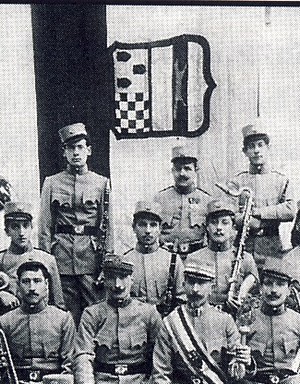
Croatian Bokelj Music in 1910 in Kotor, Boka kotorska
(source: Milos Milosevic, Tripo Schubert: Tri hrvatska glazbenika i skladatelja,
Hrvatska revija, 2, Zagreb 2007, pp. 49-58). Note Croatian Coat of Arms.
A result of the assimilation and systematic persecutions from the Serbs and Montenegrins in the Boka kotorska region was that the population of the Croats began to diminish rapidly since Yugoslavia was created in 1918, and especially after the aggression against Croatia in 1991. Let us illustrate only the “silent” ethnical cleansing in the ex-Yugoslav period (1918-1991). Namely, while in the period from 1910 (when the last Austro-Hungarian census was held) to 1991 (the last ex-YU census) the overall population in Boka kotorska doubled, on the other hand the number of Croats dropped in the same area three times.
The towns of Kotor, Perast, Tivat, Dobrota, Prcanj, Herceg Novi and Budva had a Croatian majority in 1910. A large Catholic majority in 1910 had peninsula Vrmac and southern part of Spich (from Sutomore to the border between Boka kotorska and Montenegro near the town of Bar). For example,
- the number of Croats in Kotor dropped from 69% in 1910 to 7% in 1991;
- in Herceg Novi from 70% to 2%;
- in Tivat from 95% to 23%.
In 1991 there were only 8% of Croats in Boka kotorska region, and today (after 1991-1995 Serbian and Montenegrin aggression on Croatia and Bosnia-Herzegovina) even less. For example, 350 Croatian families had to leave their native town of Tivat in the period of 1991-1998.
In June 1996 msgr. Ivo Gugic, bishop of Kotor, was cruelly killed (strangled by a wire).
The name of the town of Dobrota in Kotor bay has interesting meaning: Goodness. In fact, the French bonté is even closer to the meaning of Croatian dobrota. And there is a family name – Dobrota, that can be found also among the Croats in Konavle region south of Dubrovnik.
The photos below are from [Čurić ed.].

Croatian tamburitza choir “Napredak”, Gornja Lastva, 1919, Boka kotorska
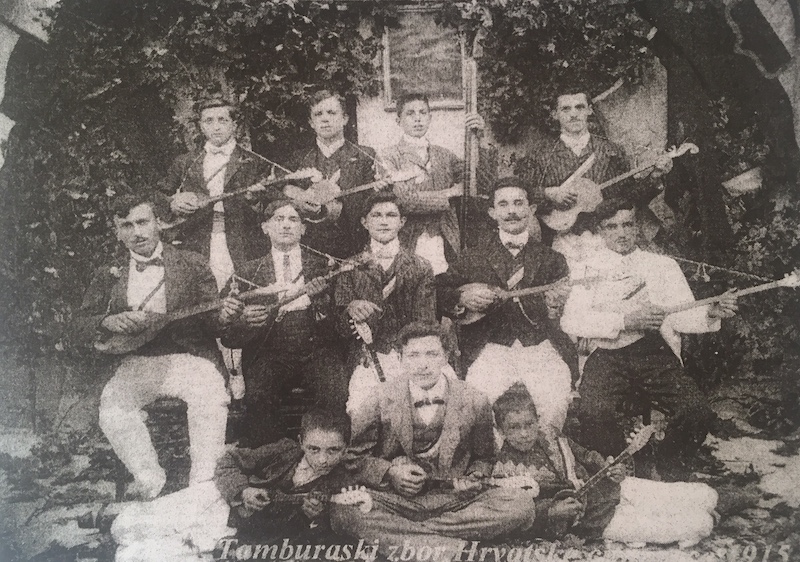
Tamburitza choir of Croatian Bavings Bank, Donja Lastva, 1915, Boka kotorska
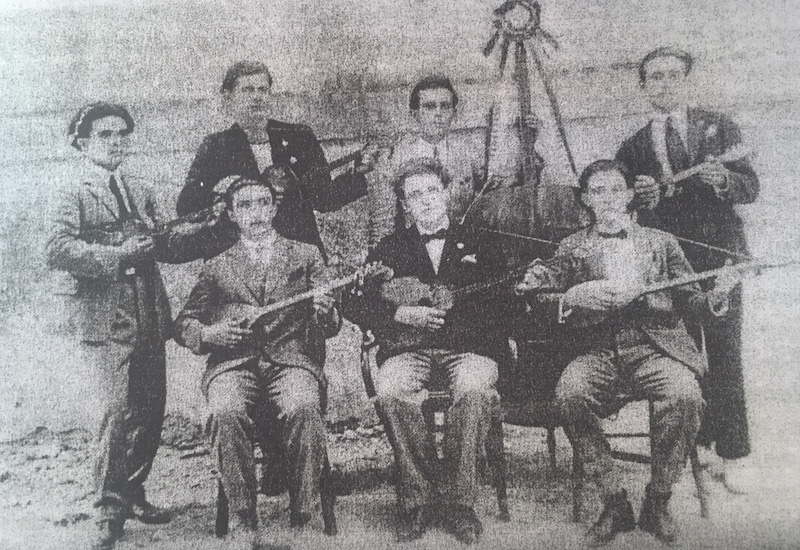
Croatian tamburitza choir “Napredak”, Gornja Lastva, 1939

Croatian tamburitza choir “Zmajević”, Perast, 1900

Croatian tamburitza choir “Starčević”, Tivat, 1906

Tamburitza choir “Sloga”, Mrčevac
Seal of the Mrčevac tamburitza choir “Sloga”
Tamburitza choir of Croatian Savings Bank, Donja Lastva, 1912.
Above the window on the right: Hrvatska čitaonica Lastve (Croatian Reading Room of Lastva).
Tamburitza orchestra “Zora” (Dawn), Dobrota, 1896
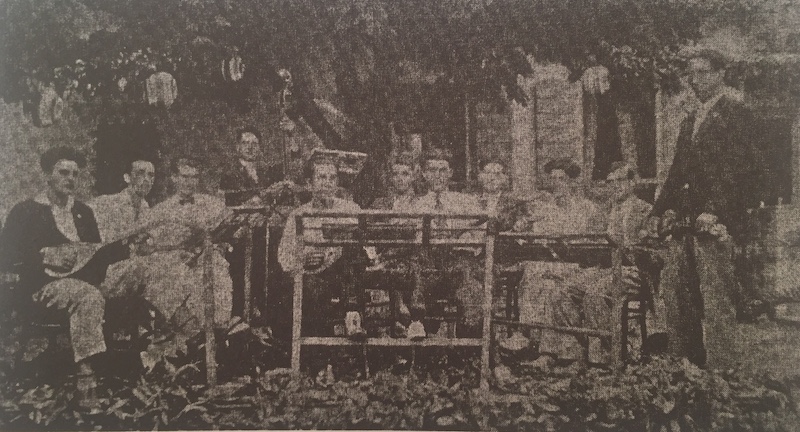
Croatian tamburitza choir Sloga, Prčanj, cc 1903, Boka kotorska
Vjenceslav Cizek (Gjenovici, Boka kotorska, 1928-2000) has passed away in Dortmund. He was born in a peasant-working class family, educated in Kumbor and Herceg-Novi, and studied philosophy in Sarajevo. For his political beliefs he was sentenced twice to a total of 17 years imprisonment, and due to savage prison tortures he became blind. After his release he lived in Germany.
He became internationally known as the “captive of conscience.” Vjenceslav Cizek was an exceptional lyricist and satirist of dictatorship. Unfortunately, his literary activity was interrupted by prison. Due to his blindness, he memorised poems while he was in prison using a special mnemonic technique. In his poems he writes about places of his youth – Boka and Konavle.
While in prison in ex Yu (in the town of Tuzla), the collection of his texts entitled Vjenceslav Čižek — borac i mučenik was published, subsequently translated into German, English, French, and even into Russian (Kontinent, 1982, p. 34; edited by Aleksandar Solženjicin). Source Hrvatski biografski lskeikon (Croatian Biographycal Lexicon)
SIN I MATI
Domovino moja trnova krunidbo,
sveto slovo glagoljskog Misala,
oku mome Ti bi svjetlost dala
da i Tvoju zlotvor nije tmicom izbo.
EPITAF (na grobu u Sinju)
Bijah samo jedno zrno
U Božjoj žitnici,
Tek jedan kamičak
U Katedrali hrvatske slobode.
Lit.
- Malkica Dugeč o Vjenceslavu Čižeku
- Vjencesla Čižek: Odabrana poezija
- Malkica Dugeč, Josip Pečarić: Vjenceslav Čižek, 2019.
- Stijepo Mijović Kočan o Vjenceslavu Čižeku [PDF]
In 1998 a new mosaic was exhibited in a Catholic chapel in the town of Budva in Boka kotorska, on the initiative of the Pravoslav Church in the city. This was done without knowledge of the Catholic Church. On the other hand, it is known that the Votive Icon of Our Lady existed on the same place from 1333 to 1949, when local yugoslav communists threw it out into the sea. Fortunately, the old Catholic icon was saved (though damaged), but it was not allowed to be placed where it had been for centuries.
It is little known that until 1949 Bosnia – Herzegovina had another entrance to the Adriatic sea in the region of Sutorine (between Prevlaka peninsula and Herceg Novi), which is today in Montenegro. Today quite unjustly the New Yugoslav state claims the right to Croatian Prevlaka. See [Macan].
Hrvatsko kulturno društvo Napredak (Croatian Cultural Society Progress) from the village of Gornja Lastva
in Boka kotorska, 1919
As confirmed by all partisan documents related to Boka kotorska and Montenegro during WW2, both regions are mentioned with clear distinction: Boka kotorska (which is defined as a coastal region from Herceg Novi to very near the town of Bar) and Montenegro. Since 1945 the name of Boka kotorska was simply erased. The name of Montenegrins (or Yugoslavs) was imposed to the Croats. Even today many Croats in Boka kotorska are hidden under the name of Yugoslavs (of Catholic faith).
Andrija Maurović (1901-1981), distinguished Croatian cartoonist and painter, was born in the coastal village of Muo near the city of Kotor.
An outstanding Croatian intellectual born in 1919 in Boka kotorska was Luka Brajnovic, professor of Ethics of the University of Navarra, a former director of the Institute of Artes Liberales, a well known Spanish intellectual. Premio Brajnovic a la communication is a prestigeous Spanish award (500,000 pesets) established in his honor during his lifetime upon the initiative of newspapermen and lecturers from the University of Pamplon.
Sveto Dekovic is distinguished Croatian sportsman (karate, judo, jiu jitsu) of international reputation (European Kyokushin karate champion 2001), living in Tivat in Boka kotorska, Montenegro.
Anton Lukovic (1815-1880), born in Prčanj, was among the principal engineers who participated in building the Suez Canal (193.3 km), completed in 1869. He worked there as an Austrian architect and civil engineer. He was proprietor of a monumental palace Dario in Canal Grande in Venice, where he died in 1880. The palace appears on the work of art by Claude Monet, distinguished French painter, which is kept in the Museum of Art in Chicago. He also had a merchant house in Cardiff. An important fortress at the entrance of the port in Alexandria was built according to his project. During this work, he discovered three old-Egyptian columns from 16-14 century BC carved with hyerogliphics, which were subsequently solemnly donated to Austrian Emperor Franz Joseph I on the occasion of the offical opening of the Suez Canal. The columns are now kept in Vienna, in Egyptian Hall of the Museum of Fine Arts. For his merits, Lukovic earned heridetary nobility from the Austrian Emeror, and the title of Lukovic de Ascrivio. For more details see an article by Siniša Luković appearing in [Vidmarović, Hrvati Boke kotorske kroz povijest, pp. 375-379].
For the reader who thinks that these claims are not sufficiently well grounded, I can offer a personal experience from the city of Zagreb, Croatia’s capital. In 1971 a census of population was held in the whole ex-Yugoslavia. At that time I was a 15 years old secondary school pupil. My math teacher “suggested” to everybody, in front of the whole class, to fill in the form as follows: “If I were on your place, I would fill in Yugoslav in the nationality section, and underline it three times.” She was a daughter of a Serbian colonel in Zagreb. It was only many years later that I realized the meaning of this “suggestion.”
- Trpimir Macan: Rt Oštra u povijesti i politici, Matica hrvatska, Zagreb 1998, ISBN 953-150-168-8
- Miloš Milošević: Iz prošlosti Boke kotorske, Matica hrvatska, Zagreb 2008.
- Stijepo Obad, Serđo Dokoza, Suzana Martinovic: Južne granice Dalmacije od 15. stoljeća do danas, Državni srhiv u Zadru, Zadar 2013., ISBN 978-953-7434-11-3
- Dominik Mandić: Crvena Hrvatska, ZIRAL (Zajednica Izdanja Ranjeni Labud), Chicago-Rim, 1973 (see other Mandic’s references related to history of Bosnia and Herzegovina)
- Pavao Butorac: Boka kotorska u 17. i 18. stoljeću – politički pregled (2000.), Kotor za samovlade (1355.-1420.) (1999.), Kulturna povijest grada Perasta (1999.) i Razvoj i ustroj peraške općine (1998.).
- Pavao Butorac: Pisma ruskog admirala Matije Zmajevića / Četiri pisma nadbiskupa Vicka Zmajevića, Zagreb 1948.
- The history of Boka kotorska from Antiquity until 1918, Based on the text “Boka kotorska od najstarijih vremena do 1918” by Ankica and Josip Pečarić. Summarized and translated by Ivica Krešić, University of Chicago.
- Josip Pečarić
- Kako su komunisti prodali Boku kotorsku
- Borba za Boku kotorsku (basic reference)
- Agneza Szabo: Hrvati Boke kotorske u doba preporoda i bana Jelačića
- Lovorka Čoralić:
- Barani u Mlecima: povijest jedne hrvatske iseljeničke zajednice, Dom i svijet d.o.o., Zagreb 2006, ISBN 953-238-015-9
- Iz prošlosti Boke – odabrane teme, Meridijani, ISBN 978-953-239-070-4
- Boka kotorska – jedno od izvorišta hrvatske pasionske baštine, Tivat, 3.-7. svibnja 2006., V. Medjunarodni simpozij, Udruga Pasionska bastina, ISSN 1334-8264
- Nada Fisković: Slikarsko djelo B. Ivankovica, Hrvatska bratovština “Bokeljska mornarica 809”-Zagreb, 2006.
- Cvito Fisković: Spomenička baština Boke kotorske, Matica hrvatska, Zagreb 2004.
- Zeljko Brguljan: Portreti bokeljskih jedrenjaka, Hrvatska bratovština “Bokeljska mornarica 809”-Zagreb, 2006.
- Dario Musić: Glasilo Hrvata Crne Gore, Hrvatska revija, 2, Zagreb 2007, 33-35
- Antun Tomić:
- Dobrota – pomorsko naselje u prošlosti, Hrvatska revija, 2, Zagreb 2007, 36-37
- Dobrota – povijesnica bokeljskog pomorstva, Hrvatsko građansko društvo Crne Gore, 2009.
- Anita Mažibradic: Prčanj – biser u riznici Boke, Hrvatska revija, 2, Zagreb 2007, 38-43
- Anita Mažibradic: Tivat kroz vjekove, Hrvatska revija, 2, Zagreb 2007, 44-48
- Miloš Milošević, Tripo Schubert: Tri hrvatska glazbenika i skladatelja, Hrvatska revija, 2, Zagreb 2007, 49-58
- Hrvatska bokeljska glazba 1910. u Kotoru, Hrvatska revija, 2, Zagreb 2007,
- Vladimir Maruvčić: Hrvati u Baru – “Ostaci ostataka”, Hrvatska revija, 2, Zagreb 2007, 59-66
- Stijepo Obad: Hrvatska društva u Boki kotorskoj do Drugoga svjetskog rata, in Stolačko kulturno proljeće, Godišnjak za povijest i kulturu, godište VII, 2009., str. 23-36
- Ivan Bongo Bolica: Opis zaljeva i grada Kotora, Matica hrvatska Dubrovnik, Dubrovnik 2010.
- Milenko Pasinović: Hrvati u Crnoj Gori s posebnim osvrtom na Boku kotorsku i drugu polovicu XX. st., Adamić, Kotor – Rijeka, 2005.
- Kotorska biskupija
- Boka kotorska, Wikipedia
- Dalmatia
- Hrvatsko građansko društvo Crne Gore
- Hrvatski glasnik, Kotor, časpis (mjesečnik)
- Đuro Vidmarović: Hrvati Boke kotorske kroz povijest; Sjećanja i zaboravi; Dux Croatorum, Tivat 2011.
- Đuro Vidmarović: Prilog povijesti Hrvata Gornje i Donje Lastve, Dux Croatorum, Donja Lastva 2013.
- Gracijela Čurić (ur.): Sidrišta zavičaja, Zbornik radova, Kotor, I 2009., II 2010.
- Vinicije Lupis: Povijest i sakralna baština crkve Male Gospe u Gornjoj Lastvi.
- Radio Dux
- Hrvatska glagoljica u Boki kotorskoj, Radio Dux
- Hrvatski glagoljički dokumenti iz Gornje Lastve
- Gornja Lastva
- Vesna Čučić: Bokelji između Boke i Trsta [PDF], Naše more, Vol 53, No 1-2, 2006, pp. 77-88.
- Vinicije Lupis:
- Biskup Pavao Butorac – Još jedna zaboravljena godišnjica
- O prijeporima o Bokeljskoj mornarici – Prisvajanjem kulturne baštine manjine većinski narod čini kulturocid, Glas Koncila, 24. svibnja 2018.
The city of Dubrovnik is under the protection of UNESCO since 1979.

